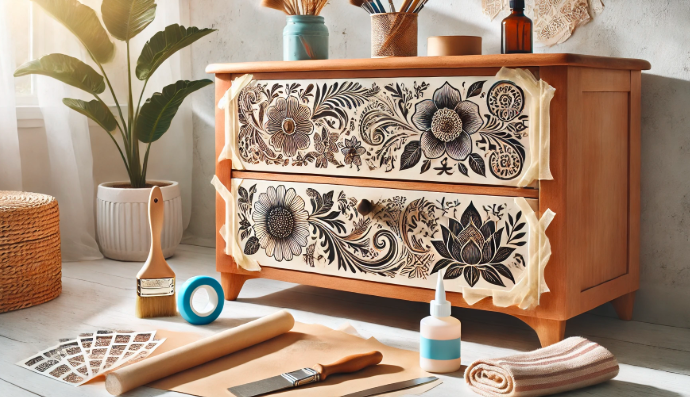Introduction to Furniture Transfers Rub On
Furniture transfers rub on are innovative decorative tools that allow you to personalize your furniture quickly and effortlessly. They consist of intricate designs that can be transferred onto various surfaces like wood, glass, and metal by simply rubbing the design with a tool. These transfers are a popular choice among DIY enthusiasts and professionals alike, offering an affordable way to refresh old furniture or add artistic flair to new pieces.
Over the years, furniture transfers rub on have become a trending solution for home decor projects. They eliminate the need for painting or extensive crafting skills, making them accessible to everyone. Whether you are looking to transform a vintage dresser or add some charm to a plain coffee table, these transfers provide endless creative possibilities.
Types of Furniture Transfers Rub On
Furniture transfers rub on come in a variety of styles to suit different tastes and projects. Understanding the options available can help you choose the right design for your needs:
Pre-Designed Transfers
These are ready-made designs that you can purchase and apply directly. They often include floral patterns, geometric shapes, or vintage motifs, catering to a wide range of aesthetic preferences.
Customizable Transfers
For those who want a more personalized touch, customizable transfers allow you to create your own designs. These are ideal for adding monograms, names, or unique patterns to your furniture.
Thematic Variations
Rub-on transfers are also categorized by themes, such as:
- Floral: Perfect for a rustic or shabby chic look.
- Geometric: Great for modern and minimalist designs.
- Vintage: Adds an antique charm to any piece.
- Seasonal: Ideal for holiday-specific projects.
Materials and Tools Needed
To apply furniture transfers rub on effectively, you need some basic materials and tools. Here’s a list:
| Material/Tool | Purpose |
|---|---|
| Furniture transfers rub on | The main decorative element |
| Applicator tool | To rub the design onto the surface |
| Sandpaper | For surface preparation |
| Cleaning cloth | To clean and smooth the surface |
| Sealant (optional) | To protect the finished design |
Having these items ready ensures a smooth and hassle-free application process.
Surface Preparation
Proper preparation of the surface is essential for the successful application of furniture transfers rub on. Follow these steps to ensure a flawless finish:
- Clean the Surface: Use a damp cloth to remove any dust, dirt, or grease. A clean surface helps the transfer adhere better.
- Sand if Necessary: If the surface is rough, use sandpaper to smooth it out. This step is especially important for wooden furniture.
- Prime (Optional): If you are working on a surface with an uneven color or texture, applying a primer can help achieve a more polished look.
Step-by-Step Application Process
Applying furniture transfers rub on is a straightforward process that can be completed in a few simple steps:
- Position the Transfer: Cut out the desired design and place it on the furniture. Use masking tape to hold it in place if needed.
- Rub the Design: Use an applicator tool or a credit card to rub the transfer firmly onto the surface. Apply even pressure to ensure the entire design adheres.
- Peel Off the Backing: Slowly peel away the backing sheet, making sure the design has fully transferred. If any part is not adhered, rub it again.
- Seal the Design (Optional): For added durability, apply a clear sealant over the transfer.
Post-Application Care
To maintain the beauty and longevity of your furniture transfers rub on, follow these care tips:
- Avoid Harsh Cleaners: Use a damp cloth for cleaning instead of abrasive chemicals.
- Reapply Sealant if Needed: Over time, the sealant may wear off. Reapplying it can help protect the design.
- Handle with Care: Avoid placing heavy or sharp objects on the decorated area to prevent damage.
Tips and Tricks for Best Results
Achieving professional-looking results with furniture transfers rub on is easy when you follow these tips:
- Test First: Practice on a small, inconspicuous area before applying the transfer to the main surface.
- Work Slowly: Rushing can lead to mistakes. Take your time to ensure precision.
- Layer Designs: For a more complex look, layer different transfers on top of each other.
Frequently Asked Questions
1. Can furniture transfers rub on be removed?
Yes, they can be removed by lightly sanding the surface or using a solvent, but this may affect the underlying finish.
2. Are rub-on transfers safe for all furniture types?
They work best on smooth, clean surfaces like wood, glass, and metal. Avoid applying them to porous or heavily textured materials.
3. How long do they last?
With proper care and a sealant, furniture transfers rub on can last for several years.
Conclusion
Furniture transfers rub on offer a simple yet effective way to elevate the look of your furniture. Whether you are a seasoned DIYer or a beginner, these transfers allow you to create stunning designs effortlessly. By following this guide, you can transform your furniture into personalized works of art that reflect your style and creativity. Start your project today and see the difference furniture transfers rub on can make!
Related Posts
Comprehensive Guide to On The Run Soultip Distributors USA
The Complete Guide to Pilgrims Cream Pomade: Benefits, Features, and Usage Tips
Ship Shape Pressure Wash: Expert Deck Restoration and Exterior Cleaning Services in Charleston, SC
Everything You Need to Know About SL55 Sealing Blades: A Comprehensive Guide


